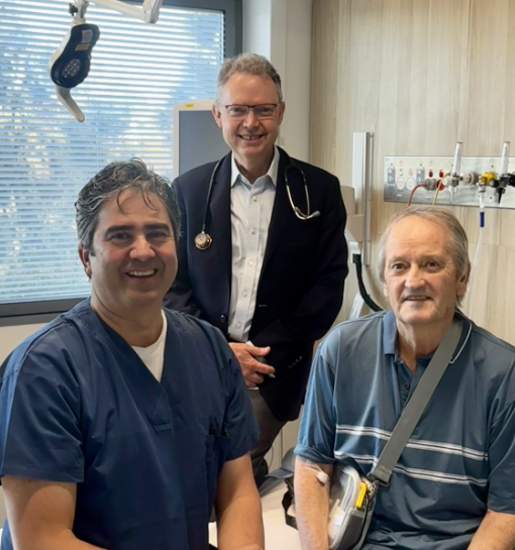- Home
- News and Media
- Latest News and Announcements
- St Vincent’s Sydney first hospital in the world to implant revolutionary new French heart device
St Vincent’s Sydney first hospital in the world to implant revolutionary new French heart device
St Vincent’s Hospital Sydney has carried out the world’s ‘first-in-human’ implant of a new generation of life-saving heart technology: a French-invented device which uses a revolutionary approach to help pump blood around the body and prevent heart failure until a donor heart for long-term transplant can be found.
The CorWave Left Ventricular Assist Device (LVAD) represents a major technological milestone in the field of mechanical circulatory support, 27 years after the first use of a durable rotary pump – a technology that has since become the standard of care.
The CorWave device uses unique, undulating ‘membrane technology' – inspired by the swimming motion of aquatic animals – to restore blood flow and mimic the natural beating and pulse of a healthy heart.
The undulating membrane technology, under development since 2012, aims to preserve the physiological balance of the cardiovascular system, unlike currently-used rotary pumps that deliver a continuous and fixed flow rate. The device has been designed to preserve the effects of heart beats on the body’s vasculature system. It works in synchronisation with the heart to preserve its function and structures, while automatically adjusting blood flow according to the patient's activity, whether at rest or in motion.
The CorWave device was implanted on 28 May at St Vincent’s Hospital Sydney in a procedure led by renowned St Vincent’s cardiothoracic and transplant surgeon, Dr Paul Jansz.
After several weeks in the ICU, followed by observation in the ward by St Vincent’s clinicians, led by heart failure and transplant cardiologist Professor Chris Hayward, patient Michael Smith – a 67-year-old grandfather and former food processing worker from Leeton in southern NSW – is on the verge of returning home and will live with the device until a donor heart is identified for transplant.
The implant is the first of around 20 that will take place over three years as part of a clinical research study to test the effectiveness of the CorWave LVAD with six hospitals participating. Four of the hospitals are in Europe, with St Vincent’s Hospital Sydney and The Alfred in Melbourne the only non-European partners.
Patient Michael Smith said he couldn’t thank the St Vincent’s team and the CorWave inventors highly enough.

"I just thought when I was tired and run down that it was just old age. I went to the doctor and said I was tired all the time. Got sent to a doctor in Griffith and he put me in hospital straight away. The next day I was on a plane coming here (to St Vincent's). It was pretty serious.
“The way I feel now is much better than the way I felt when I came here. A lot better. I'm walking around. Everything's good. I'm feeling 100% better than before I came in.
"Before the operation, I never wanted to get out of bed and go to work, I sort of made myself go. But I can't wait to get home and see my family now.
“Since the operation, I feel good. Really good. There's no tiredness. I don’t feel run down or anything. I feel really good, I feel like I'm 21 again. It's really good this machine, really good.
"I feel a million dollars, fair dinkum. I couldn't thank them (CorWave and the St Vincent’s team) enough for putting this device in me.
"You’ve got the best doctors in Australia here…it's brilliant.”
St Vincent’s Hospital Sydney’s Dr Paul Jansz said the CorWave device could be a game-changer in addressing severe heart failure.
"The surgical procedure is very similar to the implantation of the current generation of left ventricular assist devices. However, unlike the latter, this new generation system allows for the preservation of the natural pulse, which is potentially a game-changer. We could be opening up a new era of circulatory support,” said Dr Jansz.
Professor Chris Hayward said the patient’s recovery since the implant had been very positive.
"The entire medical team is impressed by the CorWave device's performance. We are happy with the patient's post-operative recovery. The results we’re seeing are very encouraging for the future," said Professor Hayward.
CorWave CEO, Louis de Lillers, said the device was the result of more than a decade of determined research and engineering.
“We owe this moment to the trust of the patient, the excellence of the team at St Vincent’s, and the perseverance of our team, investors and partners who have backed CorWave’s vision over the years.
“We look forward to writing a new chapter in circulatory support alongside the scientific and medical community, with the shared goal of significantly improving the lives of advanced heart failure patients.”
Media contact: Paul Andrews 0409 665 495
